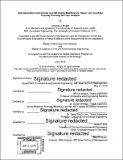| dc.contributor.advisor | Roy Welsch, Daniel Whitney, and David Simchi-Levi. | en_US |
| dc.contributor.author | Knight, Amanda J. (Amanda Joann) | en_US |
| dc.contributor.other | Leaders for Global Operations Program. | en_US |
| dc.date.accessioned | 2018-09-17T15:52:25Z | |
| dc.date.available | 2018-09-17T15:52:25Z | |
| dc.date.copyright | 2018 | en_US |
| dc.date.issued | 2018 | en_US |
| dc.identifier.uri | http://hdl.handle.net/1721.1/117979 | |
| dc.description | Thesis: M.B.A., Massachusetts Institute of Technology, Sloan School of Management, in conjunction with the Leaders for Global Operations Program at MIT, 2018. | en_US |
| dc.description | Thesis: S.M., Massachusetts Institute of Technology, Department of Civil and Environmental Engineering, in conjunction with the Leaders for Global Operations Program at MIT, 2018. | en_US |
| dc.description | Cataloged from PDF version of thesis. | en_US |
| dc.description | Includes bibliographical references (pages 73-74). | en_US |
| dc.description.abstract | A critical element in maintaining engine safety and in providing post-production service and support of a commercial aircraft engine is the complete worldwide network of maintenance, repair, and overhaul facilities. Matching forecasted shop visit demand to network-wide capacity is essential to ensuring the required resources are in place to quickly repair and return these assets to the airline customer. A capacity analysis methodology is developed to characterize and analyze the current network capacity for the PW1100G Geared Turbofan engine model for Gate 3 Engine Testing processes. This capacity model is then compared to the anticipated monthly shop visit demand for engine repair services through 2026. By identifying capacity shortages earlier in the program, Pratt & Whitney can proactively plan for and fund additional resources to improve capacity, ensuring the required capacity is in place when demand materializes to reduce shop visit delays. The results of the PW1100G capacity study are utilized both to provide recommendations for the anticipated timeframe when additional resources will be required to meet projected demand and to outline major planning milestones required to meet the resource need date. | en_US |
| dc.description.statementofresponsibility | by Amanda J. Knight. | en_US |
| dc.format.extent | 77 pages | en_US |
| dc.language.iso | eng | en_US |
| dc.publisher | Massachusetts Institute of Technology | en_US |
| dc.rights | MIT theses are protected by copyright. They may be viewed, downloaded, or printed from this source but further reproduction or distribution in any format is prohibited without written permission. | en_US |
| dc.rights.uri | http://dspace.mit.edu/handle/1721.1/7582 | en_US |
| dc.subject | Sloan School of Management. | en_US |
| dc.subject | Civil and Environmental Engineering. | en_US |
| dc.subject | Leaders for Global Operations Program. | en_US |
| dc.title | Next generation commercial aircraft engine maintenance, repair, and overhaul capacity planning and gap analysis | en_US |
| dc.type | Thesis | en_US |
| dc.description.degree | M.B.A. | en_US |
| dc.description.degree | S.M. | en_US |
| dc.contributor.department | Leaders for Global Operations Program at MIT | en_US |
| dc.contributor.department | Massachusetts Institute of Technology. Department of Civil and Environmental Engineering | |
| dc.contributor.department | Sloan School of Management | |
| dc.identifier.oclc | 1051238326 | en_US |
